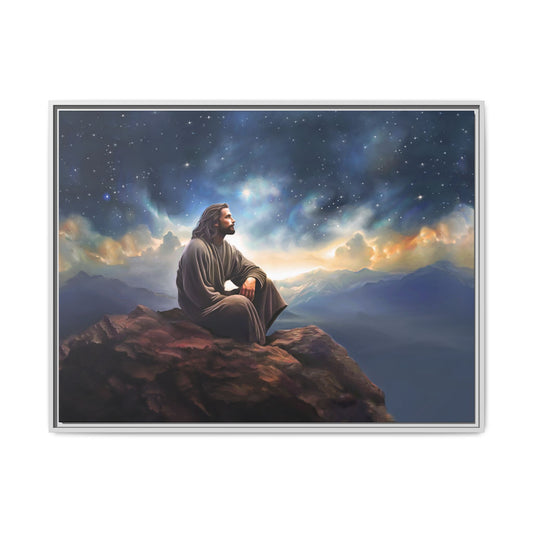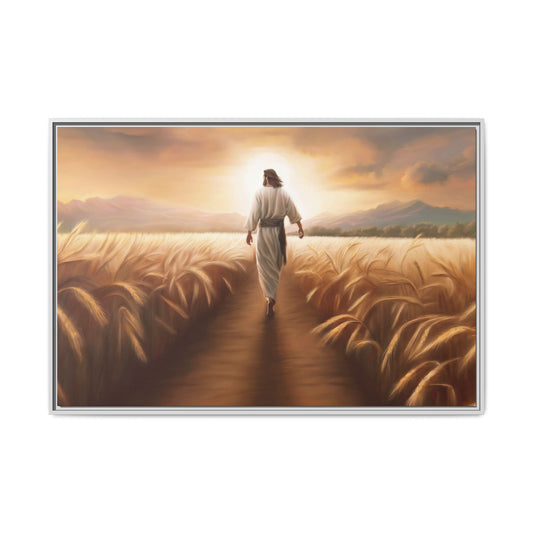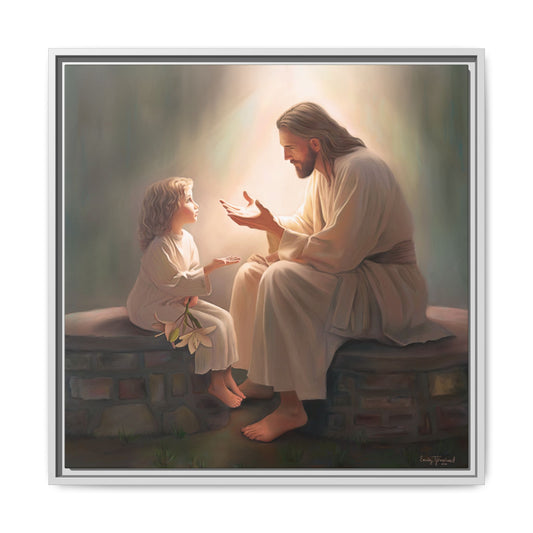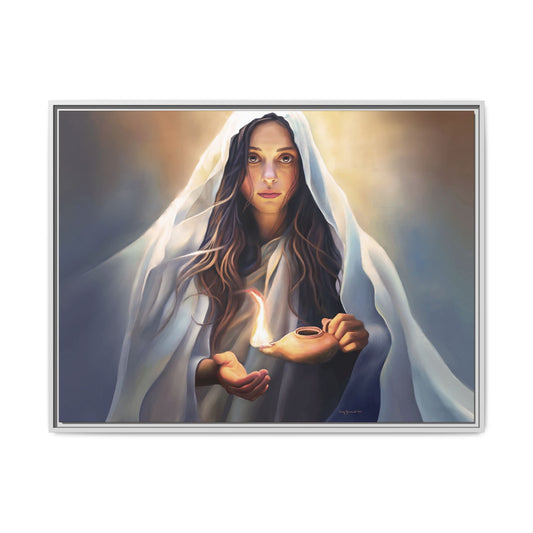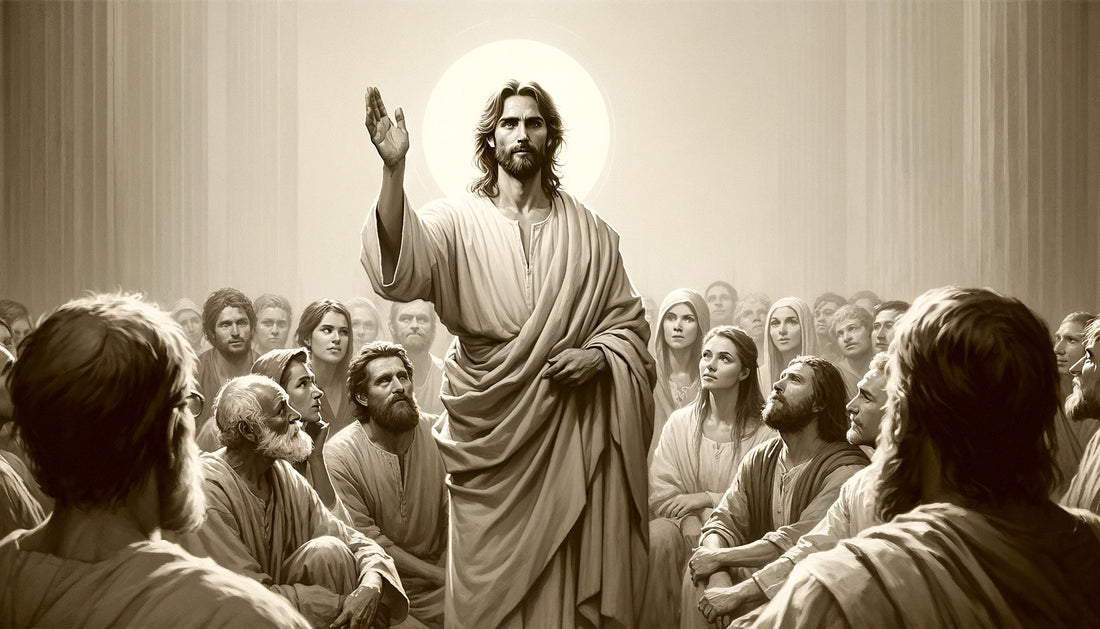
Earliest Depiction of Jesus
Share
We've all seen the iconic image of Jesus Christ, the long-haired, bearded man with his hands outstretched. But what about the earliest depictions of Jesus? How did these images of Jesus evolve and change over time? From the oldest surviving panel icon to the symbolic representations used in early Christian art, we'll explore how LDS artists have contributed to the spiritual representation of Jesus in art. We'll also look at the importance and influence of early Jesus portraits and the challenges that LDS artists face in creating art that reflects the spirit of the gospel of Jesus Christ.









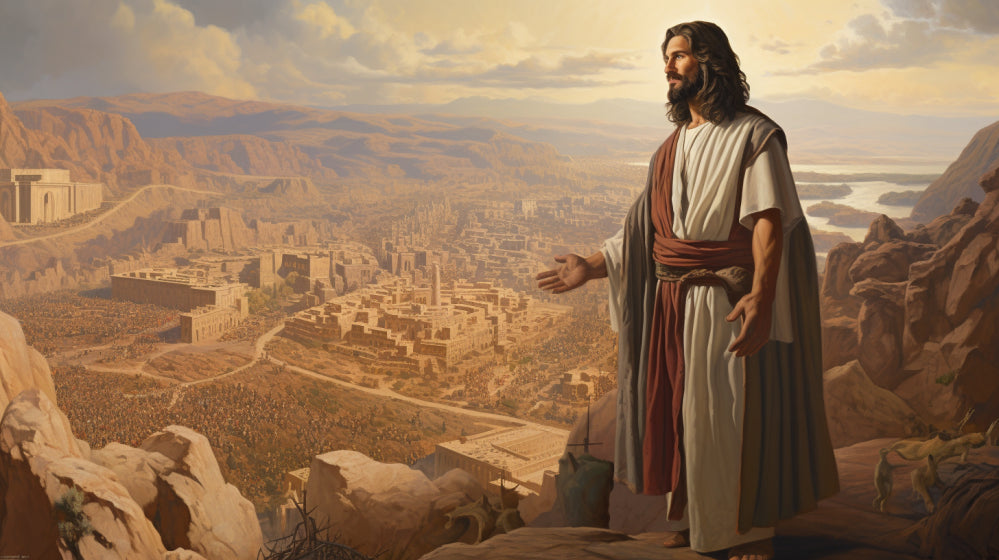






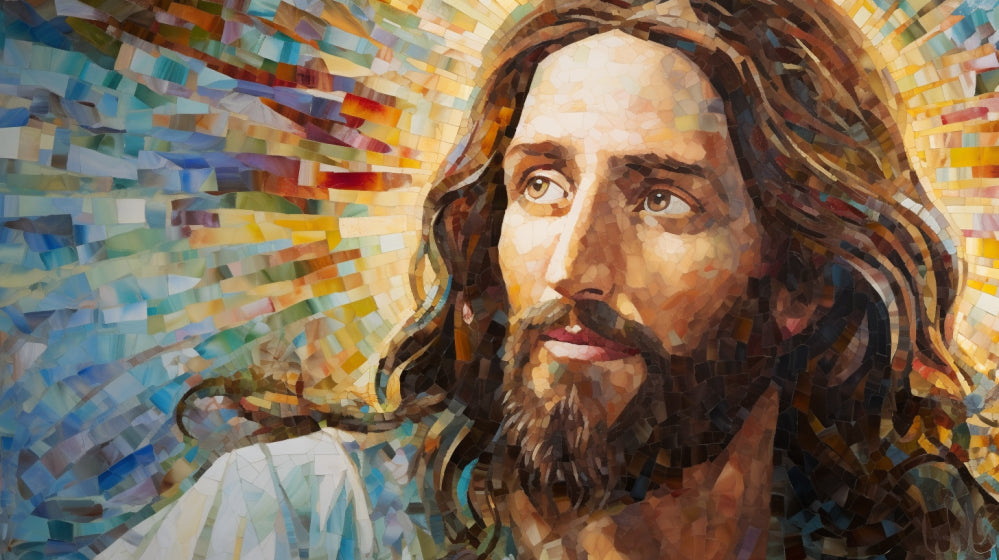




Key Takeaways
- The conventional image of a fully bearded Jesus with long hair emerged around AD 300.
- Early depictions of Jesus were much more varied, with Jesus sometimes shown performing miracles with a wand.
- Images of Jesus tend to show ethnic characteristics similar to those of the culture in which the image has been created.
- The depiction of Jesus was controversial in the early Christian period, with opposition from different Christian denominations and even iconoclasm in Byzantium.

What are the earliest depictions of Jesus
Early Christian art and architecture have provided us with a wealth of insight into the earliest depictions of Jesus. These images show a wide variety of representations, from the fully bearded Jesus with long hair to personified symbols and symbolic representations. We'll explore the significance of these early portrayals in the history of Christianity.
Brief overview of the importance of Jesus Portraits in Christian art and worship
We have seen depictions of Jesus throughout history, from the earliest surviving panel icon of Christ Pantocrator from the 6th century to the controversial Shroud of Turin. Early Christian art was furtive and ambiguous due to persecution, and early Christian leaders like Irenaeus and Clement of Alexandria disapproved of portrayals of Jesus in images. Yet, images of Jesus in art and architecture have become a powerful part of Christian worship. Symbols like the ichthys, peacock, or anchor were used to represent Jesus, while the Good Shepherd was a common representation of Jesus. Images of Jesus tend to show ethnic characteristics similar to those of the culture in which the image has been created. Art has the power to uplift and inspire, and LDS artists have made a lasting contribution to the Church and kingdom of God.
Thesis statement: Exploring the earliest depictions of Jesus in art and their significance in the history of Christianity
Building on our understanding of the importance of Jesus portraits in Christian art and worship, we now turn to explore the earliest depictions of Jesus in art and their significance in the history of Christianity. Depiction of Jesus in pictorial form dates back to early Christian art and architecture; the oldest surviving panel icon of Christ Pantocrator from the 6th century being a prominent example. Different cultures have portrayed Jesus with their own unique ethnic features, while images of Jesus tend to show ethnic characteristics similar to those of the culture in which the image has been created. Controversies and opposition to depicting Jesus have existed since the early Christian period with the Synod of Elvira in Spain in 306 prohibiting the use of images in churches. Consequently, understanding the earliest depictions of Jesus in art is significant in understanding the history of Christianity:- Oldest surviving panel icon of Christ Pantocrator from the 6th century
- Different cultures have portrayed Jesus with their own unique ethnic features
- Controversies and opposition to depicting Jesus since the early Christian period
- Jewish communities began producing figure art by the third century
- Early Christian art was furtive and ambiguous due to persecution under the Roman Empire

Historical Background
As we explore the earliest depictions of Jesus, it's important to consider the historical context in which he lived. There's a lack of direct visual representations of Jesus that date back to his lifetime. However, early Christian art and architecture began to emerge in the centuries that followed.
Overview of the time period in which Jesus lived and early Christian art emerged
Gaining an understanding of the time period in which Jesus lived and early Christian art emerged provides an important context for understanding the earliest depictions of Jesus. Jesus lived in the 1st century AD and early Christian art began to appear around the 3rd century. This period saw the emergence of:- The oldest surviving panel icon of Christ Pantocrator from the 6th century
- The use of wands as symbols of power
- Images of Jesus with unique cultural features
- Controversy surrounding depictions of Jesus
- Jewish influence on early Christian art

Mention of the lack of direct visual representations of Jesus during his lifetime
During Jesus' lifetime, there were no direct visual representations of him. Although many of his followers may have had an idea of what he looked like, it wasn't until centuries later that a standard image of Jesus emerged. This image was based on the beliefs and practices of the early Christian church, rather than any physical descriptions of Jesus during his life. For example, John's gospel describes Jesus as being of average height and stature, but doesn't provide any details about his facial features. It wasn't until centuries later that a fully bearded Jesus with long hair became the accepted physical representation of him. While some Christian denominations still believe in the authenticity of certain images of Jesus, others avoid displaying representations of him in their places of worship.
The Earliest Depictions of Jesus
Historically, the earliest depictions of Jesus were varied, often featuring him in a magical and wonder-working light. With the rise of Christianity, the iconic image of a bearded Jesus with long hair emerged, taking on different ethnic characteristics depending on the culture in which it was created. Despite the controversy, representations of Jesus have become an important part of Christian devotion.
The significance of the earliest depictions and their role in shaping Christian devotion
We have long been fascinated by the earliest depictions of Jesus and their role in shaping Christian devotion. From the 6th century Pantocrator icon to the Shroud of Turin, these images have had an immense impact on the way Jesus is perceived and how people express their devotion to Him. Oldest surviving panel icon of Christ Pantocrator from the 6th century Image of Edessa and the Veil of Veronica popular in medieval times Controversy in early Christian period due to Synod of Elvira in 306 Jesus depicted as a user of magic or wonder worker Jewish communities producing figure art by the third century These earliest depictions of Jesus have sparked debate and discussion over the centuries, leading to a better understanding of the role of art in expressing devotion to Christ. They've also been used to emphasize the importance of honoring the Lord and respecting His image.
Discussion of the first iconographic representations of Jesus in the early centuries of Christianity
Throughout the early centuries of Christianity, the earliest depictions of Jesus were varied and largely influenced by the culture they were created in. We'll explore the religious and cultural context in which these depictions arose and examine the earliest paintings and drawings of Jesus. In the religious context, early Christians were faced with the challenge of visually representing a figure who was both divine and human. This led to different interpretations and artistic styles across different regions. For example, in the Eastern Orthodox tradition, Jesus was often portrayed with a somber expression and a long beard, reflecting a sense of reverence and spirituality. In contrast, Western depictions tended to emphasize Jesus' humanity, often showing him as a young and youthful figure. The cultural context also played a significant role in shaping the visual representations of Jesus. In regions where Greco-Roman culture was dominant, artists often drew inspiration from classical art, which influenced the idealized and more refined depictions of Jesus. In contrast, areas with strong Byzantine influence tended to portray Jesus with more symbolic and abstract elements, reflecting the theological emphasis on the divine nature of Christ. Examining the earliest paintings and drawings of Jesus reveals the evolution of these depictions over time. The earliest surviving images of Jesus date back to the third and fourth centuries and were found in the catacombs of Rome. These early representations often depicted Jesus as a shepherd or teacher, reflecting the pastoral and instructive aspects of his ministry.
The religious and cultural context in which these depictions emerged
Underlying the earliest depictions of Jesus were the religious and cultural beliefs of early Christians. In particular, image restrictions from Jewish law, Christian iconoclasm, and the influence of Protestant reformers were all factors in early depictions of Jesus. These included:- Proscriptions against human and animal depiction in Jewish law
- Bans and destruction of images of Christ in Byzantine iconoclasm
- Removal of representations of Jesus in Protestant churches
- Power of symbols and personified figures to represent Jesus.

Examination of the earliest paintings and drawings portraying Jesus
Examining the earliest paintings and drawings of Jesus reveals the iconographic representations of Jesus during the first centuries of Christianity. Christian art and architecture depicted Jesus in pictorial form since the early days, though it took centuries before a standard physical appearance emerged. The oldest surviving panel icon of Christ Pantocrator is from the 6th century. Jesus was sometimes shown performing miracles with a wand, thought to be a symbol of power. Different cultures portrayed Jesus with their own ethnic features. Early Christian art was influenced by Jewish culture, which initially interpreted Exodus 20:4-6 as a proscription against any depiction of humans or animals.
The Oldest Known Painting of Jesus
We explore the oldest known painting of Jesus, believed to have been created in the 6th century. This painting, known as the Christ Pantocrator, depicts Jesus as a user of magic and power. We analyze the painting's artistic style, subject matter, and historical context to understand its significance in the history of Jesus portraits.Introduction to the oldest surviving painting of Jesus
Our oldest surviving painting of Jesus is the 6th century panel icon known as the Christ Pantocrator. This iconic image of Jesus is the oldest known depiction of the Savior, and has become a powerful symbol of His divine power. Here are a few facts about this painting and its significance:- The Christ Pantocrator is a timeless reminder of Jesus' love and sacrifice.
- The painting is a representation of the divine power of Jesus Christ.
- It's a reminder of the earliest depictions of Jesus, and the importance of honoring His image.
- It's a symbol of faith for many Christians, and its beauty has inspired many throughout the centuries.
- It's an important symbol of the old and enduring relationship between Jesus and His followers.
Description and analysis of the painting, including its artistic style, subject matter, and historical context
Taking a closer look at the Christ Pantocrator, our oldest known painting of Jesus, we can gain insight into its artistic style, subject matter, and historical context. This 6th-century panel icon was created during the Roman period, with Jesus depicted using symbols of power, such as a wand. Although this painting is the oldest surviving depiction of Jesus, earlier images of Jesus were much more varied. Jesus was often portrayed with ethnic characteristics similar to those of the culture in which the image was created. The painting was controversial in the early Christian period, with some Protestant reformers seeing images of Christ as idolatrous. Its significance lies in its representation of Jesus as a user of magic and a wonder worker, as well as its influence on the development of future Jesus portraits.Discussion of the painting's significance in the history of Jesus Portraits
The varied representations of Jesus in the Christ Pantocrator painting have had a significant influence on later depictions of him. This painting, considered the oldest depiction of Jesus to date, has shaped the conventional physical appearance of Jesus and directly influenced depictions of him in medieval times. Furthermore, the Christ Pantocrator painting has been a source of controversy and opposition, as it deviates from traditional iconography and challenges established norms. Despite this, it has remained a major influence on early Christian art and has contributed to the use of ethnic characteristics in Jesus' depiction.Who Painted the First Picture of Jesus Christ
The question of who painted the first known portrait of Jesus has been discussed for centuries. Various scholars have offered theories and evidence on this subject. In this article, we'll explore the potential candidates and examine their backgrounds and motivations for creating the portrait.
Exploration of the question: Who was the artist behind the first known portrait of Jesus
We want to explore who painted the first picture of Jesus Christ. There are various theories surrounding the artist responsible for the oldest picture of Jesus, but the most accepted view is that the first depiction of Jesus emerged around AD 300. Throughout the centuries, different cultures have portrayed Jesus with unique ethnic features. However, the initial depiction of Jesus was controversial, with some denominations seeing images of Christ as idolatrous and banning them. The earliest known example of Jesus' figure art is the frescos in the Dura-Europos synagogue, which depict scenes from the Tanakh. Early Christian art was also known to use symbols like ichthys, peacock, or anchor to represent Jesus. With all this in mind, let's examine potential candidates based on historical evidence and scholarly theories.
Examination of potential candidates based on historical evidence and scholarly theories
We've examined the history and theories surrounding the earliest depiction of Jesus, and now it's time to take a look at the potential artists behind the first known portrait of Jesus. Scholars have proposed many candidates for this honor, including the 6th century iconographer who created the oldest image of Jesus known today, Pantocrator. Although the exact identity of the artist remains unclear, some have suggested it was created by a Jewish artist influenced by the Dura-Europos synagogue frescos, while others point to the Byzantine iconoclasts. Additionally, some of the earliest depictions of Christ were represented through symbols such as the ichthys, peacock, or anchor, though these weren't necessarily portraits of the historical Jesus.
Other Early Depictions of Jesus
In addition to the earliest known panel icon of Christ Pantocrator from the 6th century, there are numerous other early depictions of Jesus that were produced in different regions and cultural contexts. These representations range from depicting Jesus as a user of magic to personified symbols like Jonah, Daniel, and Orpheus. Despite the varying styles and iconography, certain recurring themes and symbols are present in almost all of these portraits.
Overview of additional early depictions of Jesus found in various regions and cultural contexts
Where else have we seen early depictions of Jesus? In early Christian art and architecture, Jesus was often depicted with a wand, a symbol of power. He was also sometimes portrayed as a user of magic or a wonder worker. Depictions of Jesus from different cultures often had their own unique ethnic features. However, the depiction of Jesus was controversial in the early Christian period, and some Protestant reformers saw images of Christ as idolatrous. Jewish communities began producing figure art by the third century and early Christian art was furtive and ambiguous. Initially, Jesus was represented indirectly through symbols like the ichthys and peacock. The Good Shepherd was a common representation, but not as a portrait of the historical Jesus. We're indebted to the many gifted artists who've used their talents to serve God and others.
The Importance and Influence of Early Jesus Portraits
By exploring the earliest depictions of Jesus, we can gain a greater understanding of how these artworks have shaped the image and perception of Jesus throughout the centuries. They've had a significant influence on Christian worship, devotion, and theological understanding, which still resonates today in contemporary Christian art and culture.
Examination of how these early depictions shaped the image and perception of Jesus
Exploring how early depictions of Jesus influenced the contemporary image and understanding of the Son of God, we examine the importance and influence of Jesus portraits:- Depiction of Jesus in pictorial form dates back to early Christian art and architecture. Different cultures have portrayed Jesus with their own unique ethnic features.
- The depiction of Jesus was controversial in the early Christian period. Early Christian art was furtive and ambiguous due to persecution under the Roman Empire.
- Beliefs in historically authentic or authoritative images of Jesus remain powerful among some Christian denominations.

The ongoing legacy of these early artworks in contemporary Christian art and culture
Building on the impact of Jesus portraits on Christian worship, devotion, and theological understanding, the importance and influence of early Jesus portraits can also be seen in contemporary Christian art and culture. These artworks have shaped our understanding of Jesus, our culture, and even our faith. From the oldest surviving panel icon of Christ Pantocrator from the 6th century to the Image of Edessa and the Veil of Veronica, famous depictions of Jesus have become part of the Christian story. These artworks have shaped our understanding of Jesus, our culture, and even our faith.
Conclusion
In this article, we've discussed the significance of the earliest depictions of Jesus in the history of Christianity. We've explored the influence of Jewish culture on early Christian art and the controversies and opposition to depicting Jesus. Additionally, we've examined the symbolism and purpose of art, as well as the challenges faced by LDS artists.Summary of the main points discussed in the article
It is clear that early depictions of Jesus varied greatly and were often subject to controversy and opposition, but LDS artists have made a lasting contribution to the Church and kingdom of God with their spiritual works. Paintings of Jesus have been around since the 3rd century, depicting him in different ethnic characteristics. Before that, he was represented indirectly through symbols in sacred texts. Read more about the influences of Jewish culture on early Christian art. Furthermore, art has the power to uplift and inspire and brings deep satisfaction and fulfillment. We must remember that our talents are God-given and can be used for the benefit of others. Therefore, let's strive to create works that serve the King.
Reiteration of the significance of the earliest depictions of Jesus in the history of Christianity
We recognize the important role that early depictions of Jesus have played in the history of Christianity. From the 6th century icon of Christ Pantocrator to the Shroud of Turin, these images are steeped in history and religion. They've shaped the way we perceive Jesus, and continue to influence us to this day. Even in the face of controversy and opposition, these depictions have endured and become part of the new year's celebration of Jesus' birth. Historical accounts of Jesus' life have been complemented by these depictions, and they remain a vital part of our spiritual and religious heritage. Through these images, we can gain insight into the life of Jesus and learn how to better serve Him and others.
Encouragement for readers to engage with and appreciate Jesus Portraits as valuable expressions of worshipful art
Let's encourage each other to appreciate Jesus portraits as meaningful expressions of worshipful art. From the oldest surviving panel icon from the 6th century to the popular Image of Edessa and Veil of Veronica, Jesus has been depicted in a variety of forms. His image has been associated with power, magic and wonder. Despite early prohibitions, Jesus portraits have become popular throughout the world. We should appreciate the diversity of representations that depict the head of the Church, from a fully bearded Jesus with long hair to a crucified Christ. Through these portraits, we can gain a deeper appreciation for Jesus and our faith.

